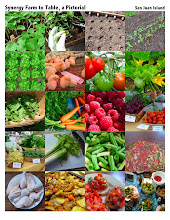 Green garlic bulbs.
Green garlic bulbs. Garlic scapes among other June and July Farmer's Market offerings.
Garlic scapes among other June and July Farmer's Market offerings. Mondo Music garlic (Music is actually the variety name.)
Mondo Music garlic (Music is actually the variety name.) The food processor making life easier.
The food processor making life easier.
 And even easier.
And even easier.
The finished soup. Double garlic, cream, a little lemon, thyme and nutmeg. Don't forget the fresh, crusty bread for dipping (in this case it is ciabatta from Cafe Demeter.)
In my mind, the key to this silky soup is a generous quantity of freshly grated nutmeg garnishing the soup. It is fun to make and sort of amazing to take three big garlic bulbs and three cups of scapes and turn it into such a smooth soup. Definitely serve it with thick toasted slices of a fresh crusty bread. If you dip a toasted slice of bread in the soup, the crunch is a wonderful counterpoint to the cream.
Though the soup is "double green" because the recipe calls for fresh garlic bulbs, whose flavor is milder, and the scapes are vibrantly green, the soup does lose it's color a bit and mellows to a murky green. To counter that, place some fresh thyme sprigs or blossoms in the center in addition to the freshly grated nutmeg.
Recipe from The New York Times3 fat bulbs green garlic,* root and green parts trimmed, outer layer removed
3 tablespoons unsalted butter
3 cups sliced garlic scapes (about 3/4 pound)
1 1/2 teaspoons fresh thyme leaves, more for garnish
3/4 teaspoon kosher salt, more to taste
Ground black pepper to taste
1/2 pound new potatoes
1 quart chicken or vegetable broth
1 cup half-and-half or whole milk
2 teaspoons freshly squeezed lemon juice, or to taste
Freshly grated nutmeg to garnish
Directions:
Chop green garlic by hand or in a food processor. In a soup pot, melt butter over medium-high heat. Add green garlic and sauté until translucent, about 3 minutes. Add scapes, thyme, salt and pepper, and sauté for 5 minutes.
Stir in potato and broth, reduce heat to medium, and simmer until scapes and potatoes are tender, about 20 minutes. Add half-and-half, and purée soup with an immersion blender or pour into a regular blender. Stir in the lemon juice and season with more salt and pepper. Garnish with nutmeg and thyme leaves, and serve hot.
* If green garlic isn't available at the farmer's market, use two-thirds are much regular garlic. Though if green garlic isn't available, then garlic scapes probably aren't either, and it just isn't the time of year to make this soup.

















































